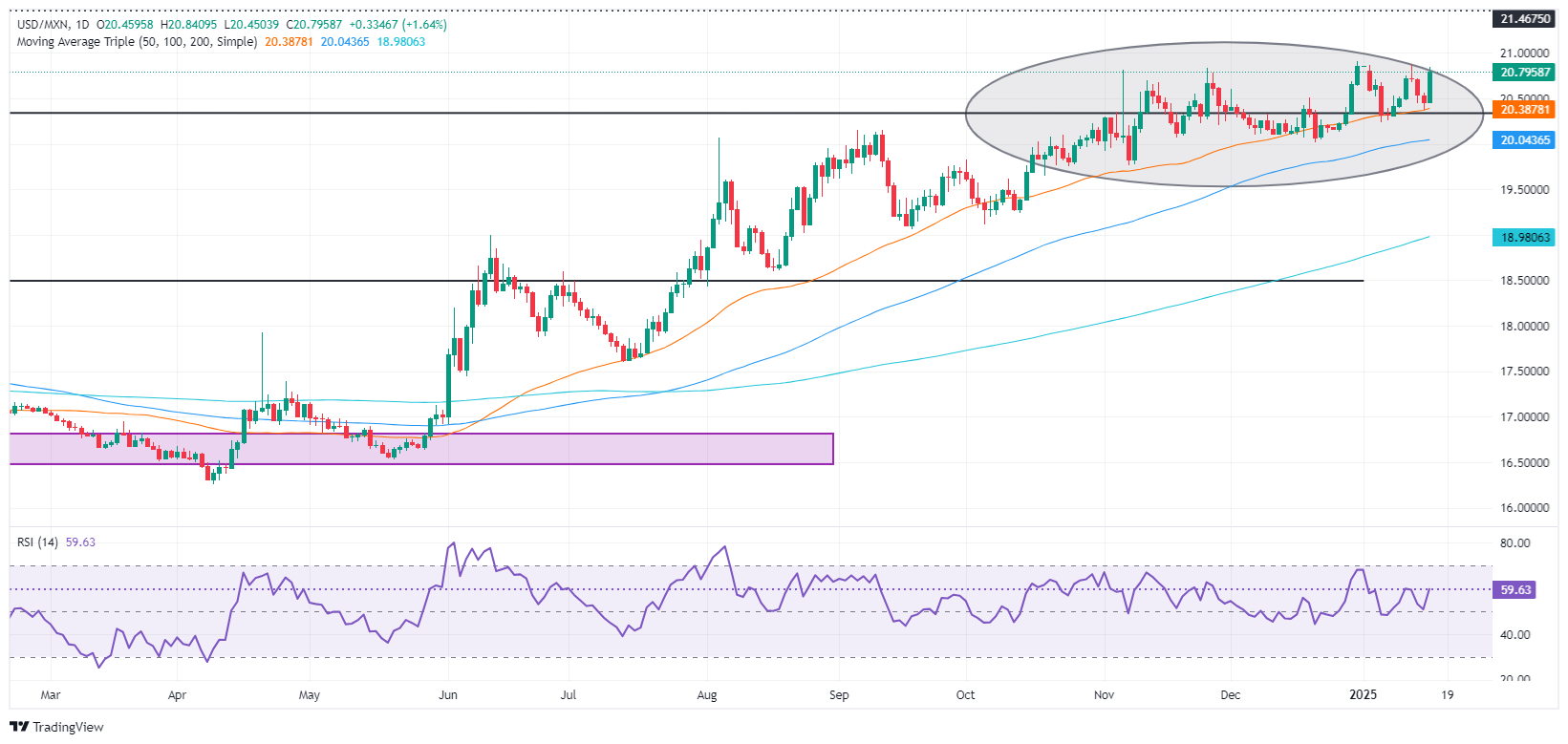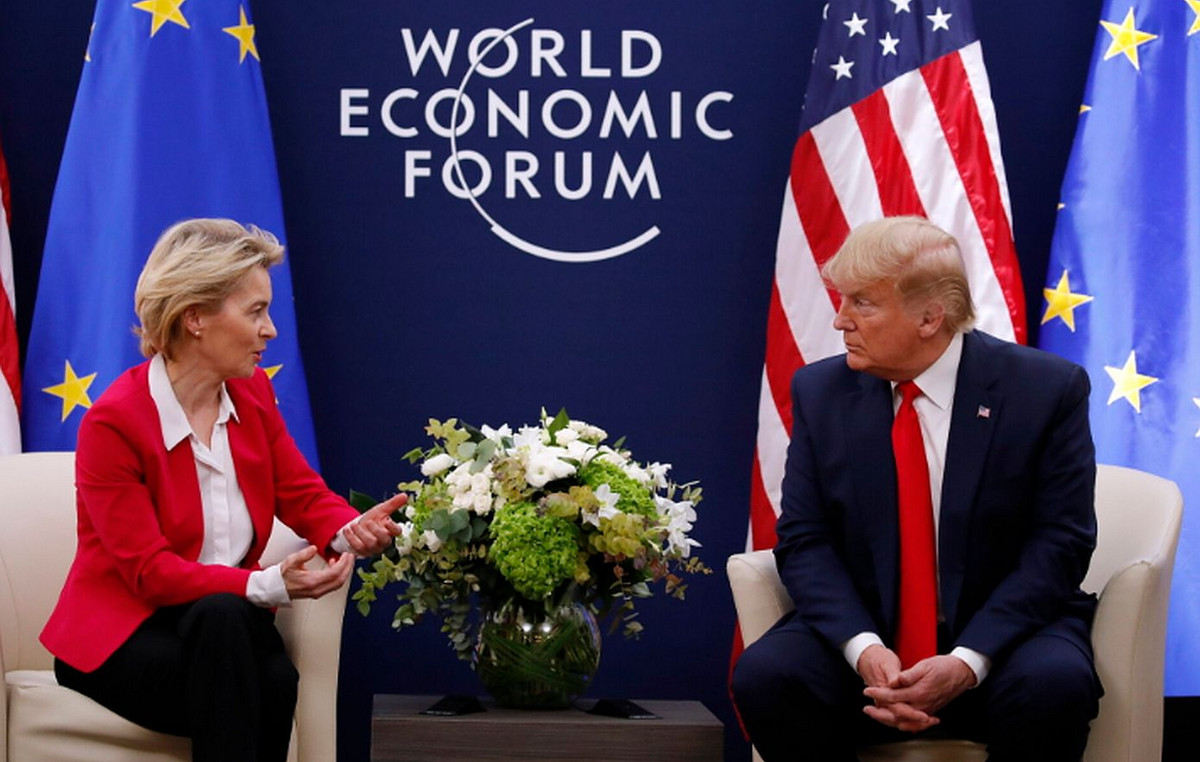- The Mexican Peso weakens amid the release of US economic data and upcoming political events.
- Mexico’s Gross Fixed Investment shows a slight improvement in October, still below previous highs.
- Fed Governor Waller suggests more aggressive rate cuts may depend on future economic data.
The Mexican peso (MXN) fell to a three-day low against the US dollar (USD) as traders digested economic data released in the United States (US) and financial markets prepared for the inauguration of the president-elect of USA, Donald Trump, next week. USD/MXN is trading at 20.80, gaining more than 1.30%.
Mexico’s economic agenda for the week revealed that Gross Fixed Investment improved in October, standing at 0.1% monthly, compared to a contraction of 0.7% in November data. However, the figures reported by the National Institute of Statistics, Geography and Informatics (INEGI) remained anemic compared to the double-digit figures revealed in April 2024.
In the US, December retail sales revealed by the US Census Bureau remained strong despite falling short of projections, although an upward revision to November figures indicates the economy remains healthy .
Meanwhile, Federal Reserve (Fed) Governor Christopher Waller sounded dovish during an interview with CNBC, stating that the US central bank could cut rates sooner and faster than projected if the data supports it. they justify.
This week, Mexico’s economic agenda remains absent, with investors awaiting next week’s inflation data along with retail sales. In the US, the calendar will include housing data.
Daily Market Summary: Mexican Peso Pressured by Trump Policy Speculation
- The Mexican Peso will continue to be pressured the closer we get to Trump’s inauguration, as there are fears that he will impose tariffs and a tough immigration policy.
- Furthermore, the divergence between the Bank of Mexico (Banxico) and the Fed favors further increases in the USD/MXN, since the interest rate differential would be reduced by 150 bp.
- According to Citi’s latest survey of private economists, Banxico is expected to cut rates by 200 basis points in 2025. The Fed projects to cut 50 bp, according to the latest Summary of Economic Projections (SEP).
- US retail sales for December rose 0.4% month-over-month, missing the mark. However, an upward revision of November figures to 0.8% showed the economy remains robust.
- Initial jobless claims for the week ending January 10 rose to 217,000 from 203,000 the previous week, missing estimates of 210,000.
- Money market futures had priced in 40 bps of Fed rate cuts in 2025, according to data from the CME FedWatch tool.
USD/MXN Technical Outlook: Mexican Peso Plunges as USD/MXN Rises Above 20.80
On Thursday, the exotic pair resumed its uptrend, with traders targeting the yearly high (YTD) at 20.90. At the time of writing, USD/MXN faces strong resistance at 20.86, the January 13 high, ahead of the latter. Further upside is anticipated once those levels are cleared, with the next key resistance levels emerging at 21.46, the March 8, 2022 high, followed by 21.50 and the psychological level of 22.00.
On the other hand, if USD/MXN breaks above the 50-day SMA at 20.34, this will expose the 100-day SMA at 20.00, followed by the October 18 low of 19.64.
Mexican peso FAQs
The Mexican Peso (MXN) is the most traded currency among its Latin American peers. Its value is largely determined by the performance of the Mexican economy, the policy of the country’s central bank, the amount of foreign investment in the country and even the levels of remittances sent by Mexicans living abroad, particularly in the United States. . Geopolitical trends can also affect the MXN: for example, the nearshoring process (or the decision by some companies to relocate manufacturing capacity and supply chains closer to their home countries) is also seen as a catalyst for the currency. Mexican, as the country is considered a key manufacturing center on the American continent. Another catalyst for the MXN is oil prices, as Mexico is a key exporter of the raw material.
The main objective of Mexico’s central bank, also known as Banxico, is to keep inflation at low and stable levels (at or near its target of 3%, the midpoint of a tolerance band between 2% and 4%. %). To do this, the bank establishes an appropriate level of interest rates. When inflation is too high, Banxico will try to control it by raising interest rates, which makes borrowing more expensive for households and businesses, thus cooling demand and the economy in general. Higher interest rates are generally positive for the Mexican Peso (MXN) as they lead to higher yields, making the country a more attractive place for investors. On the contrary, lower interest rates tend to weaken the MXN.
The publication of macroeconomic data is key to evaluating the state of the economy and can have an impact on the valuation of the Mexican peso (MXN). A strong Mexican economy, based on high economic growth, low unemployment and high confidence is good for the MXN. Not only does it attract more foreign investment, but it may encourage the Bank of Mexico (Banxico) to raise interest rates, particularly if this strength is accompanied by high inflation. However, if economic data is weak, the MXN is likely to depreciate.
As an emerging market currency, the Mexican Peso (MXN) tends to rise during periods of risk, or when investors perceive overall market risks to be low and are therefore eager to engage in investments that carry higher risk. . Conversely, the MXN tends to weaken in times of market turbulence or economic uncertainty, as investors tend to sell riskier assets and flee to more stable safe havens.
Source: Fx Street
I am Joshua Winder, a senior-level journalist and editor at World Stock Market. I specialize in covering news related to the stock market and economic trends. With more than 8 years of experience in this field, I have become an expert in financial reporting.






